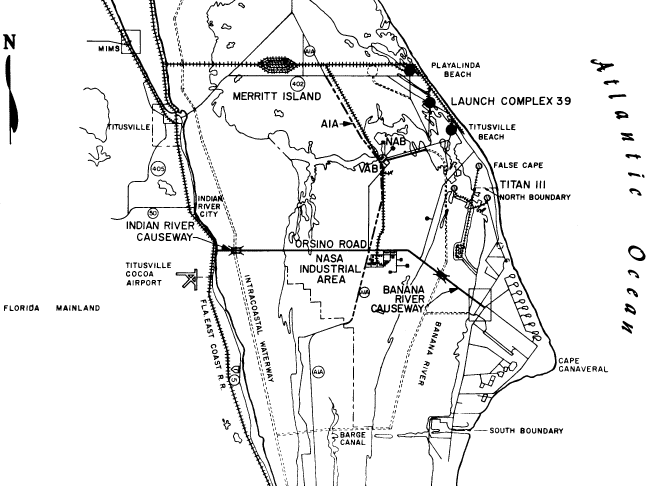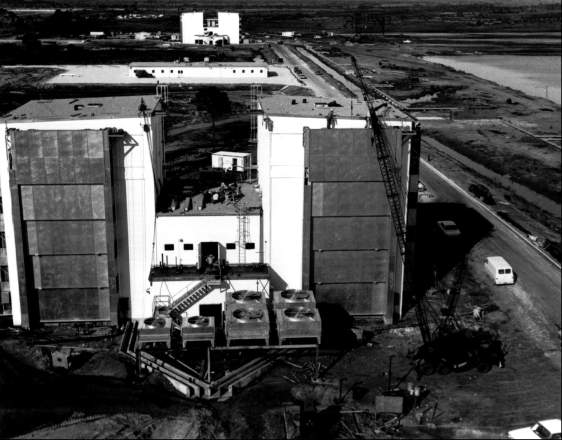
Plans for the Industrial Area
The site plan for the industrial area, eight kilometers south of the VAB, was prepared by a joint Manned Lunar Landing Program Master Planning Board made up of NASA and Air Force personnel, and its subordinate joint planning committees for facilities, instrumentation, and communications. The committees had to plan and design facilities during a period when much of the equipment that would go into them was still under development. Yet a comparison of two site plans, one prepared in March 1963, the other in October 1965 after a more careful definition of program requirements, reveals few major changes. Most of the facilities remained as originally planned.39 Some of the credit for this successful planning goes to the Air Force's contractor, the Guided Missile Range Division of Pan American World Airways. Back in December 1962 Pan American had completed a preliminary master plan for Merritt Island. The projection contained three sections: general plans for the launch area, a description of the Merritt Island industrial area, and detailed plans for the launch area. The Joint Facilities Planning Group, one of the several committees the Air Force and NASA set up, organized a task force to assist in preparation, correction, and development of this preliminary master plan. After the Webb-McNamara agreement, NASA used volume III of the Pan American master plan as a basis for its first plan, published in October 1963.40

LC-39 and the Merritt Island industrial area, December 1963. The three pads of LC-39, from south to north, were designated A, B, and C; C was never built. The NAB (nuclear assembly building) also was not built. Only two of the three Titan III sites were built.
Spacecraft support facilities took up the eastern half of the industrial area. Although the requirements for these facilities and equipment originated with the Manned Spacecraft Center in Houston or with its Florida Operations launch team, the responsibility for planning, siting, funding, and construction rested with the Launch Operations Center. Included among the Apollo mission support facilities were the following:
- Operations and checkout building
- Supply, shipping, and receiving building
- Weight and balance building
- Ordnance storage facility
- Fluid test complex, consisting of:
- Hypergolic test building
- Cryogenic test building
- Environmental control systems building
- Support building
Although it was always intended that the spacecraft modules (and the launch vehicle stages) would arrive at LOC in a flight-ready condition, the mechanics of shipping and the checkout process itself required that certain spacecraft parts be packed separately. Inevitably in the course of testing, some components had to be replaced, and those removed had to be returned to their makers for repair or modification. Also, various items of ground support equipment associated with the checkout and assembly processes were shipped with the spacecraft. The supply, shipping, and receiving building would provide the space for these functions. It was a one-story, L-shaped building of standard construction, with approximately 3,720 square meters of floor area that included a machine room, a roofed-over loading dock, shipping and receiving and supply departments with a humidity-controlled storage area, a ground support equipment area, and cleaning, painting, carpentry, maintenance, and plastic shops.
The Planning Board isolated the facilities with hazardous operations in the southeast corner of the industrial area. KSC personnel frequently referred to the area located over a kilometer from the operations and checkout building as the "south 40." The facilities there included the weight and balance building, the ordnance storage building, and the fluid test complex. At the north end of the area was a 300-meter range for testing the rendezvous radar on the lunar module.
After checkout in the operations and checkout building, the spacecraft was to be moved to the weight and balance building, where the launch team would install solid-propellant motors, the launch escape tower, and various pyrotechnic items. After weighing and balancing the assembled spacecraft to determine its center of gravity, technicians would optically align critical components. Here, also, the spacecraft would receive its final servicing prior to departure for the VAB. The building would consist of a high-bay area having an overhead crane with a hook height of 30 meters and two adjacent low-bay areas. A door, of sufficient height and width to accommodate the assembled spacecraft in a vertical position, would take up almost all of one side of the building.

Hypergolic building, fluid test complex, Merritt Island industrial area, under construction. The large doors were raised in sections, giving access to two large test chambers, which were served by common facilities in the lower, center section. Liquid and gas lines would enter the building in the concrete conduits beneath the fans.
Contained under pressure in the spacecraft were environmental control, hypergolic, and cryogenic systems, all of which used corrosive and highly combustible fluids. Careful handling was obviously required. Because of the hazards in testing, adjusting, and verifying the proper operation of these systems and their component parts, and because the test methods were somewhat similar, the several buildings where these operations would be performed were grouped in the fluid test complex. The test buildings differed in size, but were similar in form. Each contained one or two test cells equipped with high-capacity exhaust systems, a floor system for collecting and diverting spilled fluids, and fire extinguishing systems. Adjacent to the test cells were control rooms designed and constructed to protect test operators from explosions or toxic fumes. An equipment storage room, dressing or locker rooms, and machinery rooms were included in each test building. Nearby was a support building containing offices, shops, and laboratories. It was air conditioned and equipped with a special filtering system to provide clean conditions in the laboratories. Miscellaneous service facilities for the test complex included stations for the parking of mobile fluid transfer tanks, and a dilution system and disposal dump for spilled fluids.
The ordnance storage building, slightly less than 370 square meters in floor area, would provide an environmentally controlled storage area for solid-fuel motors and aligned escape towers. This was designed to prevent any deterioration of explosives that could result in a misfire in space.41
| Next |